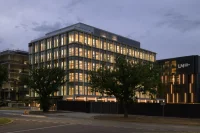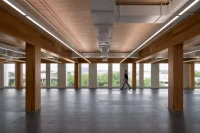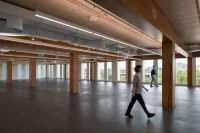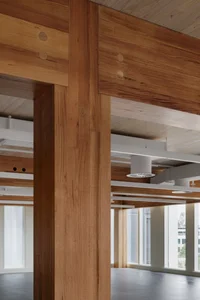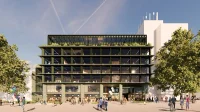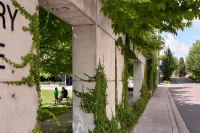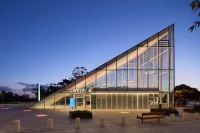23 National CircuitTree House
The first mass timber construction office building in Canberra, and the first for our practice, this considered workspace signals a growing momentum toward sustainable construction methodologies in wood, and an increasing recognition of the importance of user wellness. It also proves that healthy, planet-first buildings can add significantly to commercial value.
The first mass timber construction office building in Canberra, and the first for our practice, this considered workspace signals a growing momentum toward sustainable construction methodologies in wood, and an increasing recognition of the importance of user wellness. It also proves that healthy, planet-first buildings can add significantly to commercial value.
Location
Barton
State
ACT
Country
Ngunnawal
Client
DOMA
Expertise
Commercial
Year
2024
Collaborators
Bloc, Indesco, Savcon, S4B, Tennant Hydraulic, Redbox, Northrops, Holmes Fire, Facade Industries, ASH
Photography
Thurston Empson
1/5
Brief
The Canberra suburb of Barton is known for its proximity to Parliament House and the prestigious governmental departments and institutions that predominate in the area. Our client, Doma, looked to develop a different kind of office building, human in scale, treading more lightly on the planet (targeting 5.5 Nabers Energy and 6-star Greenstar ratings), and expressive of their identity as a forward thinking developer – particularly as one of the floors has become their new headquarters. The building also negotiates a tricky, prominent site at the centre of a precinct of innovative offices yet to be built. Long and narrow, access has been preserved across it to a pod hotel, also owned by Doma.
The Canberra suburb of Barton is known for its proximity to Parliament House and the prestigious governmental departments and institutions that predominate in the area. Our client, Doma, looked to develop a different kind of office building, human in scale, treading more lightly on the planet (targeting 5.5 Nabers Energy and 6-star Greenstar ratings), and expressive of their identity as a forward thinking developer – particularly as one of the floors has become their new headquarters. The building also negotiates a tricky, prominent site at the centre of a precinct of innovative offices yet to be built. Long and narrow, access has been preserved across it to a pod hotel, also owned by Doma.
Design
The cross-laminated timber (CLT) structure forms the identity of the six-storey building, hovering over a heavier concrete base and wrapped in a lantern of floor-to-ceiling glazing through which the cross-bracing is clearly visible. Staying true to the structure, unnecessary layers of fit-out are minimised and the servicing left exposed. The building is softened by a green wall at the rear to curtain it from the hotel, which itself is accessed by a landscaped walk along the northern elevation. The core and amenities are located along the more solid southern side. Externally this is kept quite sculptural as it sits on the site boundary; deep reveals to the other elevations help with shading, giving around 30% coverage to the glazing. We kept the structural grid very rational, adding soft spots so tenants can interconnect floors if they wish, and with the large timber spans allowing for extensive variety in layout.
The cross-laminated timber (CLT) structure forms the identity of the six-storey building, hovering over a heavier concrete base and wrapped in a lantern of floor-to-ceiling glazing through which the cross-bracing is clearly visible. Staying true to the structure, unnecessary layers of fit-out are minimised and the servicing left exposed. The building is softened by a green wall at the rear to curtain it from the hotel, which itself is accessed by a landscaped walk along the northern elevation. The core and amenities are located along the more solid southern side. Externally this is kept quite sculptural as it sits on the site boundary; deep reveals to the other elevations help with shading, giving around 30% coverage to the glazing. We kept the structural grid very rational, adding soft spots so tenants can interconnect floors if they wish, and with the large timber spans allowing for extensive variety in layout.
Impact
The building is made from over 280m3 of Tasmanian grown Eucalyptus regnans, obilqua and delegatensis trees. This volume of timber is regrown in Tasmania every 74 minutes.
Minus the embodied energy of production, these trees captured 115,772kg of equivalent C02 in their lifetime. Specifying locally grown and manufactured timber avoided the carbon emissions associated with overseas shipping.
The timber has been finger jointed with bolts which allows the building to be deconstructed at the end of its life and for the timber be re-used or recycled.
The building runs on 100% electricity and prioritises passive thermal strategies to optimize operational energy efficiency.
The building is made from over 280m3 of Tasmanian grown Eucalyptus regnans, obilqua and delegatensis trees. This volume of timber is regrown in Tasmania every 74 minutes.
Minus the embodied energy of production, these trees captured 115,772kg of equivalent C02 in their lifetime. Specifying locally grown and manufactured timber avoided the carbon emissions associated with overseas shipping.
The timber has been finger jointed with bolts which allows the building to be deconstructed at the end of its life and for the timber be re-used or recycled.
The building runs on 100% electricity and prioritises passive thermal strategies to optimize operational energy efficiency.
